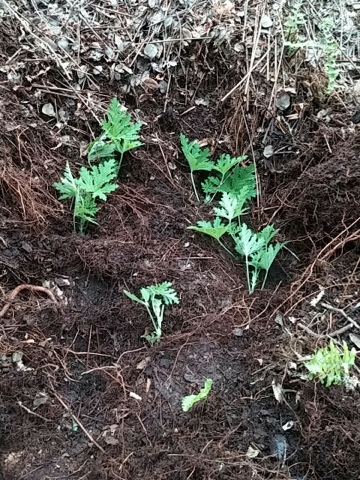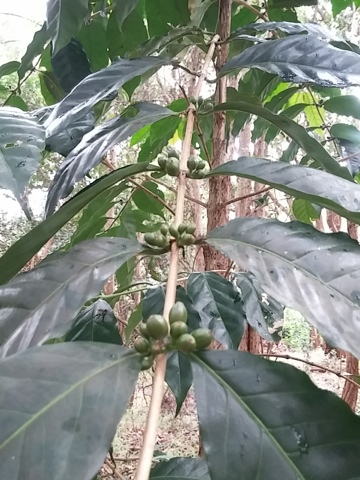When I think of animal life in Ka'u, of course I think of those that I tend to notice. Just like most places, there is plenty of animal life around but most is not noticed, like insects, spiders, nocturnal animals. And some I'd like to not notice, or have them not notice me! ....ticks, scabies mites, mosquitos, flies, centipedes, crab spiders, and all the other annoying nasties.
That a nasty, this is a golden orb spider that's very common around here.
Mammals ..........
Dogs are more popular here in Ka'u than I was use to anywhere else I've lived. Pampered pets. Guard/watch dogs. Hunting dogs. Ranch working dogs. Personal assistance dogs. They can be seen riding inside cars, in the back of trucks, in livestock carriers, atop cattle trailers, even occasionally on motorcycles, scooters, bicycles, and ATVs.
Where people travel, you'll find their dogs along. Dogs running around town is much more common than the places I've lived before, with the exception of when I initially was in Taiwan, though that situation is now changed. I'll see the "regulars" running around Naalehu, Pahala, and Waiohinu. Most people leave free running dogs alone although our mainland transplants seem to have the compulsive need to round them up. And people living down the more isolated roads have to deal with the much maligned feral and abandoned dogs. Because they frequently attack livestock, most are shot on sight. Cats are not quite visible as the dogs, but there's a lot more of them. While lots of people keep cats as pets or ratters, feral cats abound. The National Park and County Parks actively kill feral cats, as do some residents, but most ferals are tolerated as long as they are neutered.
Small mammals include both wild ones and pocket pets. Mice and rats come to mind, for sure. Rabbits are plentiful in Ka'u, and guinea pigs are common enough. The much hated mongoose seems to be everywhere.
You wont see the Hawaiian monk seal too often but it uses the Ka'u beaches to rest. It doesn't breed here or call it home, but like many visitors to Hawaii, some like to bask on the beaches.
Who can miss seeing the big mammals -- horses, donkeys, cattle, sheep, goats, pigs. Most are the domestic type, but there are plenty of ferals up in the hills. Feral pigs, Spanish goats, mouflon, and escaped cattle that now breed in the upper forests. Ka'u hosts a large population of large livestock.
Gee I almost forgot the Hawaiian hoary bat. I occasionally see one working the field over my big garden area. And I've spied a few while driving at night.
Birds.........
(One of the pheasants that lives on my farm.)
Ka'u is home to a nice assortment of native birds, although there is far less of them since non-native critters were introduced. My top favorite that I've seen on the farm is the I'o, the Hawaiian hawk. Even though I've lost chickens to this hawk, I still like the idea of having the hawks around. Another native bird that I've only seen once at the farm is the pu'eo, the Hawaiian owl. My number two favorite. Non-native birds are everywhere in good numbers. Cardinals. Mynah birds. Doves. Finches of many kinds. English Sparrows. Canaries. White Eyes. Barn owls. Even plenty of turkeys, mostly the Rio Grande variety. Then there are the pet birds: parrots, lovebirds, finches, macaws, cockatoos, parakeets. And farm birds include chickens, ducks, geese, and peacocks.
And how can we forget the nene? The Hawaiian goose. There's a pair not far from our farm. Plus the water oriented birds along the shore, the plovers, ducks, and such.
Others.........
Little lizards and geckos are very common. My farm is loaded with them. The Jackson chameleon also exists here though it's more difficult to spot. The purposely introduced cane toad is here.....I'd like to strangle the idiot that approved releasing them in Hawaii. They are incredibly prolific and have killed hundreds of dogs. And the coqui frog has established itself in a couple of locations in Ka'u, much to the regret of most residents. There are no native land turtles but a few people have turtles or tortoises of various types as pets. Of the sea turtles, Ka'u sees the hawksbill and the green turtles visiting the beaches in order to rest.
Then there's the snake. You've probably heard that Hawaii has no snakes. Well, not quite true. Here in Ka'u we have the accidentally introduced blind snake. But very few people say that they've seen one. They are often mistaken for a 6 inch long black worm.
Fish are often kept in ponds for food, mosquito control, and hobby breeding. Guppies. Swordtails. Mosquito fish. Tilapia. Koi. I'm not aware of others, but the possibility is surely there.
The ghosts......occasionally there are reports of animals we are not sure are accurate. Hunters reported seeing axis deer. That turned out to be true. The State actively set out to eradicate them recently. They may have been successful.
Sometimes people claim to have seen an iguana or a snake. Obviously a released pet, if the report is accurate. I've never seen one although a farmer up the road from me claims that an iguana lived in his orchard or many months before disappearing into the Ka'u Forest Preserve...to live out a lonely life of a single.
So it appears that Ka'u can be called home by many critters. Including a bunch of us humans.....a surely destructive invasive species. I wonder why we haven't been put on the banned list yet.







































